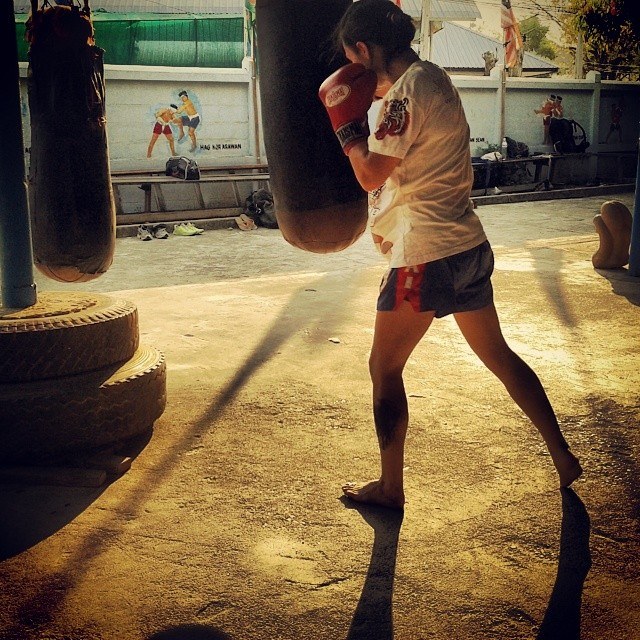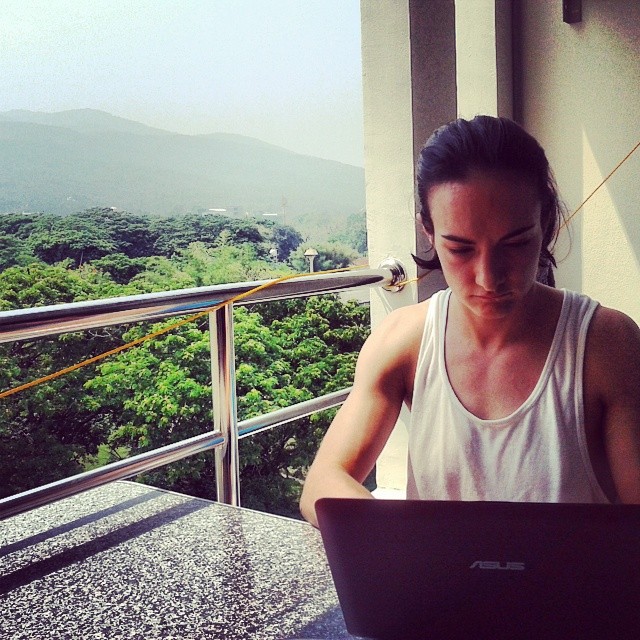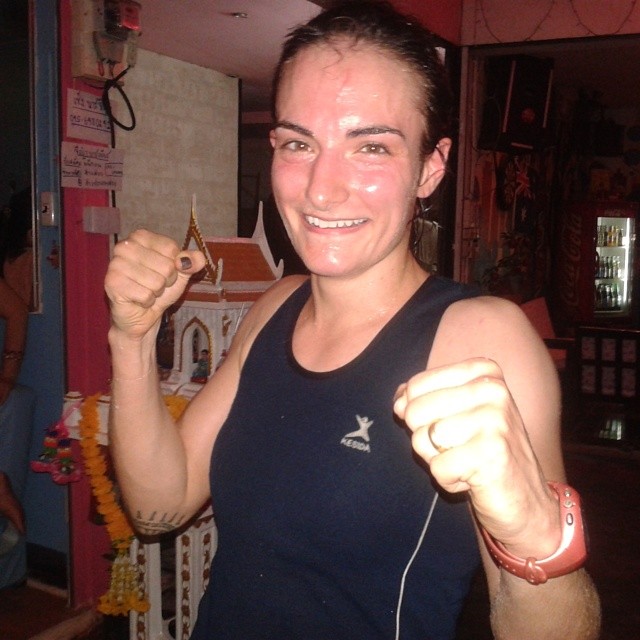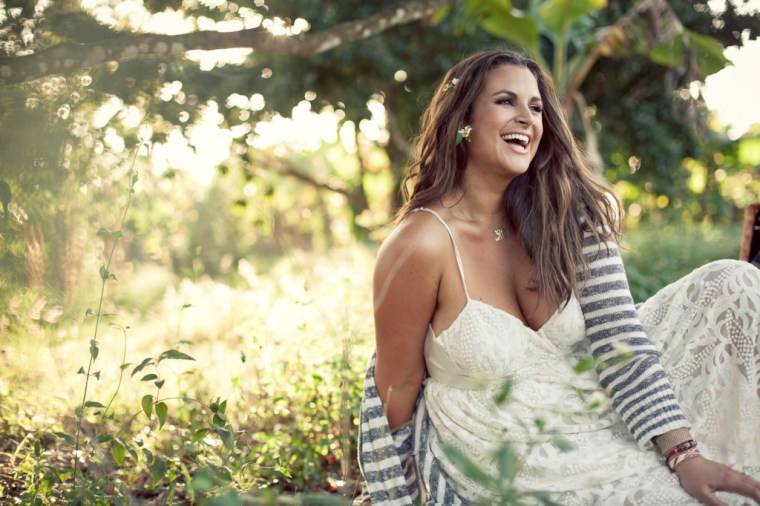When I first began The Comfort Zone Project, I had it in my head that not only was I going to join a gym and get fit, I was going to learn the art of Muay Thai. One reason being that muay thai is one hell of a workout, and the other being that the sport is so popular in Thailand, it would be great to learn more not only about it in terms of the physical aspect, but also the cultural.
Well.
I have yet to get involved in the learning of the sport, but I did manage to connect with Sylvie von Duuglas-Ittu. The Muay Thai fighter has been living in Chiang Mai with her husband for two years. I wanted her take on the sport, what it’s like to live in Thailand and what takes her out of her comfort zone.

Sylvie: I don’t consider myself an “expat.” We came to Thailand in order to focus on Muay Thai because this is the best place in the world for learning and practicing the sport/art. We chose Chiang Mai because we’d been here at this camp before and my opportunities for frequent fights and a variety of opponents near my size is greater than in other areas of Thailand.
D: It is very easy to fall into the trap of not doing much/drinking/etc. What is life like for you as an expat in Chiang Mai?
S: Muay Thai camps see a lot of tourists in and out, with varying degrees of commitment both in time and effort. Some folks stay only for one session, some for a few days and up to a month or more. But, more than a couple weeks is pretty rare. None of the folks here on the short-term are “expats” but they are mostly young travelers who seem to experience their tours in foreign countries through the lens of partying. I think for a lot of tourists, Thailand is a fantasy space and it’s both viewed and treated as an adult playground — an extended “Spring Break” trip. That’s unfortunate, I think, although for many of those people that experience is satisfying. For me, because I have a focus, spending all my time training, studying Thai language and writing my blog, 8 Limbs, is very gratifying. I simply don’t have an interest in hanging out all night with westerners who are on a transient path through Thailand, one stop of many. For me, it’s easy to avoid because it holds no appeal for me. And one simply cannot commit to both late nights of booze AND 6:30 a.m. start to six-hour days of training. I consciously, and happily, choose the latter every day.

D: How did you get involved in muay thai? Did this happen in Chiang Mai or before you relocated?
S: I started Muay Thai in the US in 2008. I was living in New York and commuting an hour in each direction to train with an absolutely incredible man named Master K, who is a 75-year-old Thai man still practicing Muay Thai and teaching it out of the basement of his home in New Jersey. He instilled in me the love for Muay Thai that is a “way of life” rather than simply an exercise or sport. My husband and I relocated to Chiang Mai in order to pursue Muay Thai full-time (for me; my husband doesn’t train) and get as much fight experience as possible; something that is very limited in the US at this point in time.
D: What makes muay thai such a great work out?
S: Muay Thai is also called “The Art of 8 Limbs” because it uses strikes from the fists, elbows, knees and legs. Using every part of your body in the practice means both that you are going to be exercising your full body, but also it is rare (especially for women) to appreciate all of your body at once, rather than picking one limb or feature to highlight or hide. There’s no hiding in Muay Thai! However, an important point to realize is that Muay Thai is a job for fighters, nakmuay, in Thailand — it’s a job for me — so simply calling it a workout does not come close to what is invested by those of us who practice Muay Thai as a way of life.

D: How easy is it to get involved in the Muay Thai scene in Chiang Mai?
S: Very easy. There are numerous gyms in Chiang Mai and surrounding areas. Most of the camps are within a proximity to one another so that you could easily visit more than one from a central location and decide for yourself which suits you best. My camp, Lanna Muay Thai/Kiat Busaba, is located near Chiang Mai University and near the foot of the Doi Suthep mountain, so it’s a really lovely area and easy to access by bike or public transport, as well as being near lots of accommodation options. All gyms offer day rates (single session or single day, depending on the camp), as well as weekly and monthly, so it’s very easy for anyone to just “drop in” and try a session or get a discount for longer stretches of training.
D: Can you describe the muay thai scene in Chiang Mai?
S: There are about four stadiums in Chiang Mai, almost all of which are within walking distance of each other, and located around the Night Bazaar. There are fight programs scheduled for every night of the week and big shows on weekends. Fighters come from all over, from big camps with familiar names (once you’ve attended two shows you’ll start to recognize the names already) to tiny gyms in family yards where the pedagogy is passed down from parent or uncle to children — very traditional. There’s a lot of gambling at some of the venues and that lends to the excitement of the atmosphere. Usually, westerners fill up the seats directly around the ring and the gamblers stand in the back. There are usually one or more “foreigner vs. Thai” bouts on a card, which are a big draw for tourist audiences. Sometimes, the matchup looks a little funny, simply because westerners can be pretty big and there aren’t Thais of that same size, so you’ll see a big western guy against a much smaller Thai — but usually the Thai makes up for the size disparity in experience and these fights can be really exciting. The cards usually start with the smaller and less experienced fighters, like young boys with a handful of fights, and progress toward the “Main Event” of bigger, more experienced fighters or the westerners on the card.

D: Has muay thai changed your body image? How was your body image before you started the sport?
S: I’ve always been athletic but I’ve never committed to a practice like I have to Muay Thai. My body is very “functional” for me, so how it looks is much less on my mind than how it performs. I’m quite muscular, which gets a lot of attention in Thailand, but I’m recognized as a fighter almost instantly here — like an assumption to explain the aesthetic — whereas in the US I was often asked “do you work out a lot?” So, there’s a level of pride to that recognition that I think makes up for the unwanted attention I get for looking the way I do. Muscles on women is not so hot in contemporary Thai aesthetic, so I think I’m more self-conscious of it than I would be back home. The women I fight don’t look like me – but because a strong body is appreciated in Muay Thai for its function, that lends to confidence nonetheless.
D: What challenges do you face to maintain your health and fitness in Chiang Mai? And how to you solve these challenges?
S: I don’t face challenges. I’ve heard western men at the camp complain about the expense of protein powder and supplements in Thailand, but I don’t partake in either so it’s not a bother to me. I find no difficulty in locating nutritious and delicious food and health care is significantly more affordable here than in the US, so if I need to see a doctor I can actually afford to go see one, which I couldn’t do in the US. So it’s actually easier for me here.
Follow along with Sylvie’s Muay Thai experience on Facebook, Instagram and Twitter, or go check out her gym when in Chiang Mai.
Photos courtesy Sylvie von Dugglas-Ittu


